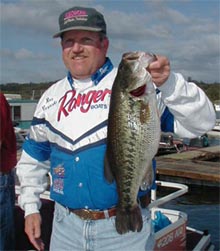 I am honored to be a member of the WesternBass.com pro staff family and to be able to share some of my fishing tips and experiences with you.
I am honored to be a member of the WesternBass.com pro staff family and to be able to share some of my fishing tips and experiences with you.
As most Southern California bass anglers know, when the annual springtime spawning season is occurring, we get to enjoy some of the best bass fishing of the year. Our deep, clear water lakes allow us the opportunity to sight fish for giant bass of the likes not found in many other areas of the state, or even the country. There is nothing more exciting than locating a huge bass and then enticing it into biting your offering. Although sight fishing for bedding bass can sometimes be very frustrating and very time consuming, when you finally do get these fish to bite, the fight is fast and furious.
But what about after the spawn, or post spawn as we call it? Why does the magic of the spawn just suddenly and relentlessly shut down completely? Needless to say, post spawn fishing can be brutal and downright frustrating, not to mention heartbreaking. It can be a total letdown from the excitement that we enjoyed just a few weeks, or even a few days earlier, while the spawn was in full swing. Although post spawn fishing can be difficult, it is certainly not impossible to catch bass during this time of the year, if you have the right attitude and have a basic understanding of what the bass are doing.
After a female releases her eggs, she and the male will tenaciously guard the eggs for several days. Then, the female just sort of saunters off into deeper water to recover from the exhaustion of spawning. The male bass will remain at the nest to guard the eggs and, later, the fry against predators. These male bass are usually very easy to catch, as they will attack anything that they deem a threat to their young. Ultimately, the male bass will abandon the fry when he is simply too exhausted to continue chasing predators away.
During the first three or four weeks immediately following the spawn, neither the male nor female bass eat very much or very often. That's the bad news. The good news is that, after those three or four weeks, the built-in mechanism that kept them from eating their own young immediately following the spawn is turned off and the dinner bell rings. This can be one of the best fishing times of the year as the bass begin eating in abundance, including baby bass. As such, this is a great time to throw baby bass colored reaction baits, such as crankbaits, jerkbaits, and spinnerbaits in a baby bass pattern. This is also my favorite time of the year to throw topwater baits such as an Iovino Splash-It, a Super Spook, a Sammy, and my personal favorite, a buzzbait. This topwater bite is usually an early morning and late afternoon thing on our Southern California lakes, and when it ends, its time to start dropshotting, splitshotting, and shaking plastic worms. As far as worm colors, I try to stay with darker colors such as Roboworm's Aaron's Magic and Black Grape in low light situations, and lighter colors like Roboworm's Oxblood light with red flake when the sun is bright. The new Roboworm FX colors are also very effective during the post spawn and well into the summer.
Areas to key in on during the post spawn are exactly the same areas that you focused on during the pre-spawn. These include steep and deep banks and inside secondary points of the major spawning coves. (After all, the bass simply reverse their migration route out of the major spawning coves as they head for deeper water and into their summer patterns).
Don't let anyone convince you that our post spawn bass are impossible to catch. This is simply not the case. Although post spawn fishing won't be nearly as exciting as fishing during the spawn, there are still plenty of bass to be caught. One of the key factors to remember is that all of our bass do not spawn at the same time. In fact, in Southern California, our bass will sometimes spawn two or even three times in a single season, and can spawn well into the summer months or even into the fall. Remember, our bass will spawn in deeper water as the water temperature rises. So, in reality, we can actually fish for pre-spawn, spawning, and post spawn bass simultaneously, and for several months. The fish are there, you've just got to be willing to go out and find them.
Thanks for your time and always remember: "The shortest distance between two points is a reef!"
Ron Cervenka


 Advertising
Advertising